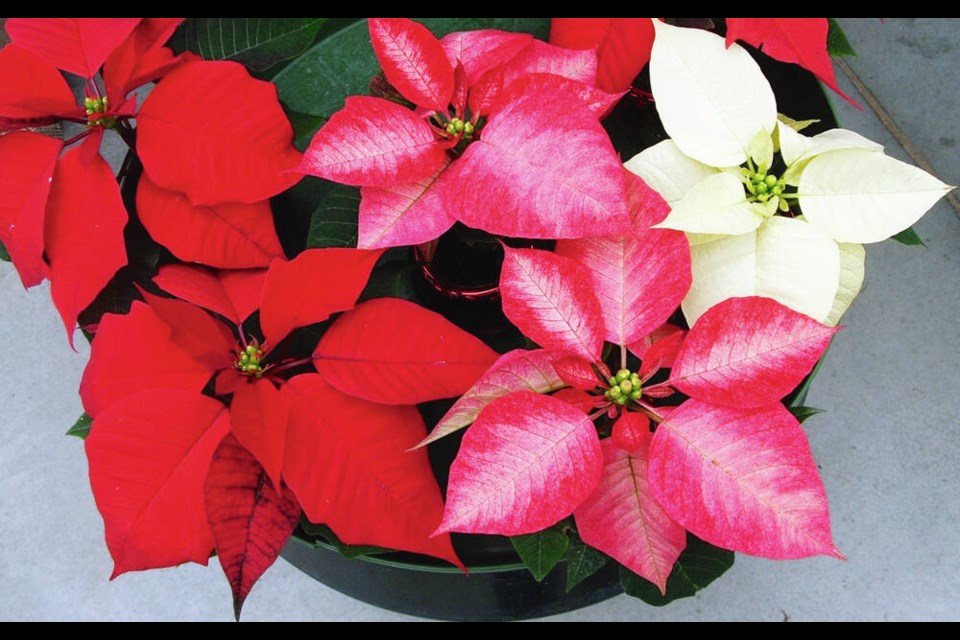Dear Helen: I want to select a gift plant for an elderly aunt who lives in an apartment that she keeps moderately warm. The plant needs to be as care-free as possible. Can you suggest plants that are colourful and cheery without being demanding?
H.D.
Avoid azaleas, cyclamen and chrysanthemum. They are lovely, but they stop flowering and tend to wilt in warm temperatures and dry air.
If you’d like to be seasonal, select a poinsettia. They’re available from very small to huge sizes and you’ll find interesting variations in colouring. Poinsettias often last in fine decorative condition until spring in bright light, with watering when the pot feels light when lifted.
Rieger begonias are very showy and stay in bloom for a long time at a bright window. African violets are probably the most tolerant of very warm room temperatures. The brightest light possible in winter, warmth, and high humidity levels all help to prolong bloom.
Dear Helen: I’m disappointed to see that the “sprouts” on my Brussels sprouts plants are open and leafy rather than tight and button-like. Why would this happen?
P.G.
Sprouts that fail to form firm buttons and develop instead in a more open, leafy fashion are called “blown” sprouts. Conditions that foster the problem are the same ones that tend to produce “heartless” cabbages, that is ones without a tightly formed head.
The main causes are not enough well-composted organic matter in the soil, a soil that is loose in texture, and a failure to firm plants in well at planting. An excess of nitrogen in the soil has also been known to yield loose sprouts. Inadequate soil moisture during dry weather can contribute to the condition as well. It is helpful, early in the fall, to mulch around the plants with compost and press it down well.
Pinching out or cutting away the plant tips late in September helps to hasten sprout development and will encourage the last, uppermost sprouts to fill out fairly quickly. Those small balls of tip growth are delicious steamed and eaten with butter, salt and pepper. Leaving the plant tip intact delays formation of the upper sprouts for an extended harvest period.
Some authorities recommend removing blown sprouts as soon as they are noticed.
Dear Helen: For a few years now, I’ve tried to deal with raccoons digging up my lawn. Previously, the damage would begin in July and last for about a month. This year, it is still happening in December. Last year I caught about three every week in a live trap and soon realized there were too many to realistically deal with that way. I’ve tried applying nematodes to control the grubs that raccoons dig up under the turf. That did not work. I would appreciate any suggestions on what else I could try.
S.S.
Parasitic nematodes, released at the appropriate time, during the second half of July, can control moderate populations of the grubs. For the nematodes to do their work, they need moisture in the soil following application.
Raccoons usually do their major digging for grubs on my lawn in the fall, and again in late winter and early spring. When digging activity is observed, if the lawn is a small area it’s fairly easy to put barriers to their digging in place. Black plastic bird netting held down with metal pins works. Keeping the netting in place between late autumn and early spring, outside the mowing sea son, is convenient.
Chafer beetles target grassy areas for egg laying, from mid- June through July. If lawn areas are not too large, covering the grass between mowings with insect netting or floating row cover will prevent egg laying.
The beetles have a preference for laying eggs in closely mown lawns. Mowing high, no shorter than six cm, will make the turf less appealing for egg laying, and the longer grass will also encourage deeper rooting for a stronger lawn — as long as it is watered infrequently but deeply.
Clover lawns are not damaged by this pest. Microclover is the best choice. Among the grasses, tall fescue is the least attractive to the beetles. If you overseed to repair damaged areas, use a combination of these two. Wait until February or March. Arrange bird netting or chicken wire over seeded areas to prevent their being dug up in the raccoons’ search for grubs.



